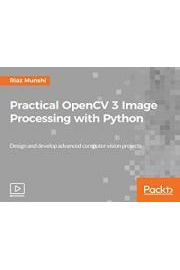Practical OpenCV 3 Image Processing with Python is a show that delves into the world of image processing using OpenCV, an open source computer vision and machine learning software library. In season 1 episode 4, titled "Image Derivatives," the focus is on the mathematical concept of derivatives and how it applies to image processing.
The episode begins with a brief introduction on the concept of derivatives, explaining the process by which we can calculate the rate of change of a function. This concept is then applied to image processing, where derivatives can be used to identify the edges and corners in an image.
The host sets up a simple example of an image of a square and demonstrates how the first and second-order derivatives can be used to identify the edges of the square. They explain that the first derivative measures the rate of change of the intensity of the image, which is high at the edges and low at the flat areas. The second derivative measures the rate of change of the gradient of the image, which is high at the corners and edges.
Moving on to more complex examples, the show demonstrates how the Sobel and Scharr operators can be used to calculate the image derivatives. The host shows the difference between the two operators and their respective strengths in identifying the edges and corners in an image.
The episode also covers the concept of Laplacian of Gaussian, which is a second-order differential operator used to detect the edges and corners in an image. The host explains how the smoothing effect of the Gaussian filter eliminates the noise in an image while preserving the edges. They then demonstrate how the Laplacian of Gaussian can be applied to an image to identify the corners and edges.
Towards the end of the episode, the host introduces the concept of Canny edge detection, which is a multistage algorithm used to detect edges in an image. They explain the various stages involved, including Gaussian blur, Sobel operator, non-maximum suppression, and hysteresis thresholding, and show how these stages work together to produce a high-quality edge detection output.
The episode concludes with a brief summary of the key points covered in the episode, including the importance of derivatives in image processing, the various methods of calculating derivatives, and the concept of Canny edge detection.
Overall, "Image Derivatives" is a fascinating episode that showcases the power of mathematical concepts in image processing. The host does an excellent job of explaining the complex concepts in a simple and clear manner, making it easy for anyone to follow along. This episode is a must-watch for anyone interested in learning about image processing using OpenCV and Python.
-
Channel
-
First AiredJuly 30, 2017
-
Runtime3 min
-
LanguageEnglish

-
 MyFreeDIRECTV is a new free premium TV experience.
MyFreeDIRECTV is a new free premium TV experience.
-
 Enjoy a curated selection of popular free live channels and On Demand library.
Enjoy a curated selection of popular free live channels and On Demand library.
-
 Try the DIRECTV experience - All you need is the DIRECTV app.
Try the DIRECTV experience - All you need is the DIRECTV app.

 MyFreeDIRECTV is a new free premium TV experience.
MyFreeDIRECTV is a new free premium TV experience.
 Enjoy a curated selection of popular free live channels and On Demand library.
Enjoy a curated selection of popular free live channels and On Demand library.
 Try the DIRECTV experience - All you need is the DIRECTV app.
Try the DIRECTV experience - All you need is the DIRECTV app.